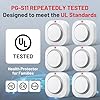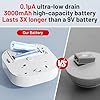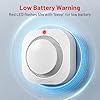Smoke detectors are an important part of any fire safety plan, but who is responsible for making sure they are up to code? The answer may surprise you.
Contents
How often should you test your smoke detectors?
Smoke detectors should be tested monthly to ensure that they are in proper working order. Most smoke detectors have a test button that, when pressed, will emit a loud sound to indicate that the device is working correctly. If your smoke detector does not have a test button, you can test it by using a piece of burning incense or a lit candle. Hold the burning object close to the smoke detector and wait for the alarm to sound.
What are the benefits of having a smoke detector?
When it comes to protecting your home and family from fires, having a smoke detector is an absolute must. Here are just a few of the benefits of having a smoke detector in your home:
- Smoke detectors can detect smoke and fire before you even see or smell it.
- Smoke detectors can alert you to fire even when you are asleep.
- Smoke detectors can give you valuable time to escape a fire.
- Smoke detectors can help reduce the amount of damage caused by a fire.
- Smoke detectors can save lives.
Bottom line, smoke detectors are an important part of home fire safety. If you don’t have smoke detectors in your home, be sure to install them as soon as possible.
What are the different types of smoke detectors available?
There are three primary types of residential smoke detectors: ionization, photoelectric, and dual-sensor detectors. Ionization smoke detectors are the most common type, and they work by using a small amount of radioactive material to ionize the air in the detector chamber. This creates a small current that flows between two electrically charged plates.
If smoke enters the chamber, it disrupts the current flow, triggering the alarm. Photoelectric smoke detectors work by shining a light source into the detector chamber. If smoke enters the chamber, it scatters the light, which is detected by a photoelectric sensor, triggering the alarm.
Dual-sensor detectors combine both ionization and photoelectric sensing technologies into one unit. These detectors are more expensive than ionization or photoelectric detectors, but they provide the best protection against both fast-flaming and smoldering fires.
What are the fire safety regulations for smoke detectors?
In the United States, the National Fire Protection Association (NFPA) is the leading source of fire safety regulations. The NFPA has published several documents related to smoke detectors, including NFPA 72: National Fire Alarm and Signaling Code and NFPA 74: Installation of Fire Alarm Systems.
Smoke detectors are required by the NFPA in all new and existing buildings, including homes, apartments, hotels, hospitals, shopping malls, office buildings, and factories. The NFPA requires that smoke detectors be installed in every sleeping room, outside each sleeping room, and on every level of the home, including the basement.
Smoke detectors must be connected to the electrical system of the building and must have a backup power source, such as batteries. The NFPA requires that smoke detectors be tested monthly and that their batteries be replaced at least once a year.
In the event of a fire, smoke detectors should be able to immediately notify the occupants of the building so that they can evacuate to a safe area.
How to install a smoke detector?
Installing a smoke detector is a simple and effective way to protect your home from fire. Smoke detectors are most effective when they are installed on every level of your home and in every bedroom.
To install a smoke detector, first find a suitable location. The best location for a smoke detector is on the ceiling in the center of the room, away from any doors or windows. Once you have found a suitable location, use a drill to make a small hole in the ceiling. Next, insert the mounting bracket into the hole and screw it into place.
Now it is time to install the actual smoke detector. Begin by removing the battery compartment cover and inserting the batteries. Once the batteries are in place, replace the cover and screw it into place. Finally, snap the smoke detector into the mounting bracket and screw it into place.
Now that your smoke detector is installed, it is important to test it regularly to ensure that it is working properly. You should also vacuum the detector regularly to keep it free of dust and debris.
How to maintain a smoke detector?
One of the most important things you can do to protect your home and family from fire is to maintain your smoke detectors. Smoke detectors are your first line of defense against fire, so it’s important to make sure they are in good working condition. Here are a few tips for maintaining your smoke detectors:
1. Test your smoke detectors monthly. Many smoke detectors have a test button that you can press to make sure the alarm is working. If your smoke detector doesn’t have a test button, you can use a piece of smoke-producing material (such as a lit candle) to test the alarm.
2. Vacuum your smoke detectors regularly. Over time, dust and dirt can build up on the sensing element, which can cause the detector to malfunction.
3. Replace the batteries in your smoke detectors at least once a year. Most smoke detectors use 9-volt batteries, so be sure to keep a few extras on hand.
4. If you have a “nuisance” smoke detector (one that goes off for no apparent reason), try cleaning it first. If that doesn’t solve the problem, you may need to replace the detector.
5. If you’re going to be away from home for an extended period of time, consider removing the batteries from your smoke detectors. This will prevent them from being accidentally triggered by a power outage or other problem.
By following these simple tips, you can help ensure that your smoke detectors are always in good working condition.
What to do if your smoke detector goes off?
If your smoke detector goes off, it is important to take action immediately. First, try to determine the source of the smoke. If you cannot find the source, or if the smoke is coming from a cooking appliance, evacuate the building immediately. Once you are outside, call 9-1-1. Do not try to re-enter the building until the fire department says it is safe to do so.
Summary
Smoke detectors are a crucial part of any home fire safety plan, but who is responsible for making sure they are up to code? The answer may surprise you.
Smoke detectors are regulated by a variety of local, state, and federal agencies, depending on where they are sold. In the United States, the Consumer Product Safety Commission (CPSC) is the primary regulator of smoke detectors.
The CPSC sets voluntary safety standards for smoke detectors, which are then enforced by manufacturers. However, the CPSC does not have the authority to recall defective products or impose fines.
State and local governments also have a role in regulating smoke detectors. Many states have adopted the CPSC’s standards as their own, and some have additional requirements. For example, California requires that all smoke detectors be certified by a third-party testing laboratory.
While the CPSC is the primary regulator of smoke detectors in the United States, it is important to be aware of the role of state and local governments in this area. By understanding the various levels of regulation, you can be sure that your smoke detector is up to code and keeping your family safe.



















